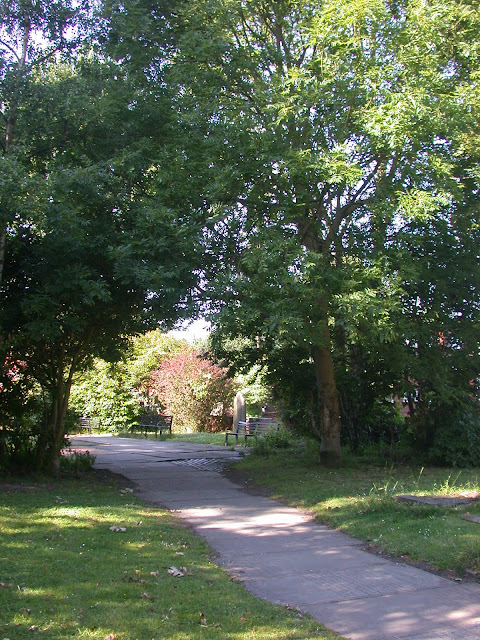Now, anyone who has taken a stroll through the old parish graveyard of St Clement’s will agree that it is pleasant spot.
 |
| The old parish graveyard, 2012 |
It is sandwiched between the village green to the north and the Bowling Green to the south and offers up a selection of benches to sit and just enjoy the moment.
Added to which there is the history of the place, which starts with the footprint of the church and continues with a collection of gravestones, which record those who were buried here.
 |
| The church yard, circa 1870-1880 |
Some were at the posh end of the community, but most were from families who made their living from the land, either as tenant farmers, agricultural labourers or in trades related to farming.
What might surprise the casual visitor is that those gravestones are just a fraction of the number which once crowded into the graveyard.
In total there were 345 such monuments, from the simple headstone to elaborate structures, and many held multiple internments.
Those 345 have yet to fade from living memory and are supported by a large number of photographs dating back into the late 19th century and as late as the 1970s.
Just how many people were buried here is difficult to say, and while an estimate can be made from the inscriptions on the gravestones, that will be a conservative estimate, given that some graves were reused over the centuries.
 |
| Samuel and Sarah Nixon, 2012 |
Chief of which was that “it is now difficult to tell where there is any land left for new graves, [and because] so many internments have taken place there is not 2ft of earth between the coffin and the surface.”*
There were also lurid tales of existing gravestones being broken up and thrown into the midden of the Bowling Green Hotel to allow new ones to be erected and worse still of bones and skulls appearing and being transported away in wheelbarrows.
 |
| The graveyard, 1976 |
Much more was revealed at the official Government inquiry opened by the Home Office in the November of 1881.
One witness spoke of “human bones .... knocking about the highway. Only that morning a jawbone with teeth in had been picked up.”
There were also past sextons who reported the difficulty in finding space to place a coffin and the ever-present danger of unearthing past burials. William Caldwell described how he regularly “disturbed human remains in digging” and once before he “could get down to any depth I smashed into another grave, and I was flooded by liquor and human remains.” **
All of which is an introduction to the Register of Grave Inscriptions of St Clement’s Old Churchyard, Chorlton Green.***
 |
| Register of Grave Inscriptions, 1975 |
And when combined with the smaller list from the Wesleyan Chapel along with the parish records of baptisms, marriages and burials it is possible to build a picture of the township.
It is a booklet I keep coming back to and one that can still shock me, like the inscription for the Swarbrick family that records that George and his wife Harriet, buried seven of their children between 1817 and 1836.
The youngest Elizabeth died just two months after she was born, while William was seven years old. Their parents had been born in the late 18th century and would live on till 1871 and 1874, although by then they were no longer living here.
There is more but that is for another day.
Suffice to say that the inscriptions were collected in the 1970s, in advance of the landscaping of the former graveyard, and sadly the loss of most of the historic gravestones.
 |
| Plan showing the original headstones, 1975 |
The bodies had already been removed in the 1930s.
But we do have a plan of where the original headstones which will allow us to to revisit the final resting places of so many of our residents.
Location; Chorlton-cum-Hardy
Pictures; the graveyard, 2012, and headstone of Samuel and Sarah Nixon, 2012, from the collection of Andrew Simpson, the grave yard, circa 1870s-1880s, from the Lloyd Collection, in 1976 from the Journal, and cover and burial plan of Register of Grave Inscriptions of St Clement’s Old Churchyard, Chorlton Green
*The Great Burial Scandal, https://chorltonhistory.blogspot.com/2020/03/the-great-burial-scandal.html
**From the Chorlton Ratepayer Association submission to the Withington Local Board of Health January 12th 1881, and references from the Manchester Guardian 1881-86, Manchester City Council Town Clerks’ Papers Re Closed Burial Grounds 1930, reports in the dig by Angus Batemean
*** Register of Grave Inscriptions of St Clement’s Old Churchyard, Chorlton Green, RG 37/99 Archives and Local History Library, Manchester Central Reference Library
Good read, but there are a few gravestones with more recent inscriptions than 1903; reference my story of 22nd August, 2020. The last internment took place on the 25th February, 1916 when Thomas Caleb Butcher was buried in the Ashcroft family grave.
ReplyDeleteThanks Tony that one I missed!
Delete